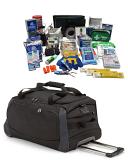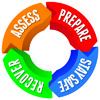   Animal owners often ask us for information about disaster preparedness with pets. Specifically, we are asked for recommendations about how to prepare a pet emergency kit for in the UK it is a legal requirement to assure animal welfare and prevent suffering which is particularly relevant during a major incident. The advice below is summarized from different sources and pertains to cats and dogs. Please seek additional information for other pets.
1. ASSESS - food, water, shelter and first aid are the primary concerns also for your pet(s) in any emergency or disaster situation and therefore supplies will need to be included in your emergency it, i.e. shelter-in-place kit and Go-Bag (Why do I need an Emergency Kit?)
- start by making your Personal Emergency Plan to fully consider your particular situation and environment, specifically noting your pet’s role and needs. In addition, consider that you may not be in the same location as your pet when disaster strikes so you will need to involve and plan for a wider support network that may include neighbours, colleagues, friends or family.
2. PREPARE - your pet should wear a collar and tags with up-to-date information and identification at all times
- microchip is one of the best ways to reunite pets with owners in case you are separated – assure you keep personal contact information updated with the microchip provider. Also consider neutering to increase the likelihood of your pet returning should it be lost
- purchase individual pet carriers and write the pet’s name and your contacts with indelible ink. Familiarize your pet before a crisis and practise transporting by taking them for rides in a vehicle similar to the one you would use in a real emergency
- practise safe handling including catching and securing your pet; consider hide-outs
- keep a leash (muzzle) and the carrier near your exit; keep additional equipment in your kits
- if you do not have a car, make transport and evacuation arrangements with neighbours, family or friends. Alternatively contact your local council’s civil protection team to learn about local emergency plans and to investigate transportation and shelter options for animals during a disaster. Be aware that not all people shelters can accommodate animals
prepare a shelter-in-place emergency kit for your pet that includes
- food and water for minimum 1 week but food for 2 weeks is highly recommended for each pet (airtight and waterproof packaging)
- bowls for food and water, manual can opener, scissors or multi-tool
- litter box and litter, plastic bags and scoops
- clean-up items for accidents and personal protective items ie disposable gloves
- medication and treats for minimum 2 weeks
- sturdy leashes, harness, muzzle, carrier, pet toys, bedding etc
- store in a waterproof folder (hard copy and digital copy ie USB)
- medical records: all vaccination and prescription records, summary of medical history, microchip number
- prepared handouts containing identification info + current photo (ie missing pet flyer)
- prepared handouts with boarding instructions ie feeding schedule, medications, notes on special needs or problem behaviours etc.
prepare Go-Bag supplies as above for your pet that will see you through the first critical 72 hours. This forms part of your immediate evacuation kit and should be strategically stored near your exit (what Kit do I need?)
- check your provisions twice a year, update your plan and supplies if necessary
3. STAY SAFEKeep informed, tune in to radio, TV etc; follow guidance of the emergency services. Shelter-in-place or evacuate as advised: If you shelter at home with your pet, assure that the room is safe and pet-friendly
- interior room with few or no windows (ventilation but no hazardous escape)
- no toxic chemicals, materials or plants
- close off small areas where frightened animals could get stuck in (vents, beneath heavy furniture etc)
- provide access to water and reassurance, monitor health and behavior
If you need to evacuate - take hold of your prepared Grab-Bag and leave quickly via your established and practised safe route
- know a safe alternative accommodation for your pets; contact your local council emergency planner and/or local vet, boarding facilities and animal shelters
4. RECOVER
Following a major incident or disaster, not only may the visual landscape change tremendously, olfactory cues also change which particularly affects animals. General safety includes:
- if you’re missing your pet, keep searching thoroughly and inform your local police and animal warden (via your council). You can also report missing animals via i.e. AnimalSearch UK, National Missing Pet Register. Make flyers and post them in your area while assuring that your pet can get back into your house if he returns. - take time to gradually re-orient your pet
- do not allow your pet to roam loose but keep them on a leash or in a confined space and gradually acclimatize them. Take particular care with downed power lines and flood waters
- re-establish some semblance of a normal routine as soon as possible and monitor behaviour closely. After a disaster, animals may become aggressive or defensive and problems may need veterinary help
Hygiene – is especially important during disaster recovery with pets …
- wash your hands before and after handling your pet, their food and their waste
- do not let animals lick your face and hands
… to avoid diseases that can spread from animals to humans (also see List of Zoonotic Diseases), for example
- rabies: a virus affecting the nervous system of both animals and people; transmitted through bites or through contact with saliva. Avoid interaction, keep vaccination up-to-date, report bite wounds immediately. More info on rabies (Gov.uk) or via the NHS
- ringworm: a fungus that infects sin, hair and nails of animals and people; transmitted through direct contact with infected skin or hair or through touching an object where an affected animal has been. Avoid interaction, use the appropriate disinfectant. More info on ringworm (NHS)
- leptospirosis: a bacterial disease found in urine of infected animals, may cause kidney damage and affect other organs; transmitted through contact, also via contaminated water, soil and food. Check vaccination, strict hygiene, avoid any stagnant water. More info on leptospirosis (NHS)
Other select resources:
Animals in Emergencies video (Northants LRF); PDF How to care for your pets in an emergency (Hertfordshire Resilience); Merseyside Prepared Pet Evacuation Kit List (Doc); Somerset Prepared How to protect your pet during a disaster PDF; UK World Animal Protection; Animals in Disaster Blog; British Red Cross Pet First Aid; RSPCA; Blue Cross; CDC DisasterPreparedness for your Pet;
Recent news: Fort McMurray's Pets And Owners Evacuated Together On Canadian North Airlines; Fort McMurray fire worsens animal displacement, 100 abandoned at shelter;
thank you for sharing! If you find this content useful then join us for even more Emergency Preparedness on |  



 
| |


















